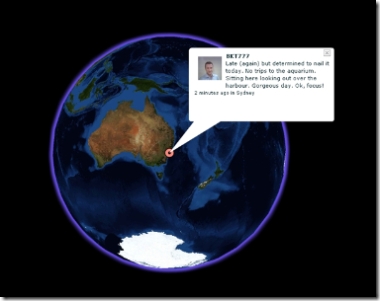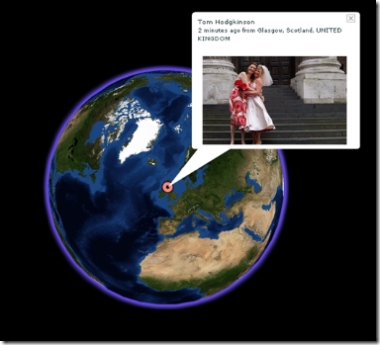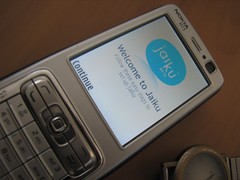Home » Twitter (Page 17)
Category Archives: Twitter
Australia’s Twitterati SAY NO to Internet Censorship
As part of a protest against the proposed Australian Internet censorship filter, many Australia Twitter users have changed their avatars to pictures with their mouths gagged or crossed out. Rene Lemerle has created this very Australian collage collating many of these protest avatars:
Can you spot me in there? 🙂 Make sure you’re doing your bit to stop the insanity of the “clean feed”!
Annotated Links of Interest: October 12th 2008
Links of interest for October 9th 2008 through October 12th 2008:
- VloggerHeads – An 18+ onlys videoblogging site where comments are – in theory – taken seriously and meaningful conversations are encouraged between videobloggers. Yes, they’ve left YouTube for good reason. There’s a good rundown on the rationale behind the site in this Wired article: “Sick of Griefers, YouTube Vloggers Start Members-Only Site“.
- A Decade of Internet Superstars: Where Are They Now? [PC World] – A puff piece looking at the trajectories of internet meme folk after their meme’s energy has run out. Would you believe Chris “leave Britney alone!” Crocker has released his own single? Jennifer “Jennicam” Ringley has completely dropped off the web after being the most visible person on it for a while. And the Ask a Ninja guys are still answering questions … like ninjas.
- Tweethearts: blogger proposes to nerd girlfriend over Twitter, she tweets back acceptance. – Boing Boing – “seanbonner: @tarabrown so, um, you wanna get hitched?” Proposal by Twitter! (She says yes!)
- Video Vortex Reader: Responses to YouTube [Institute of Network Cultures] – A fantastic collection of scholarly essays looking at YouTube as a cultural phenomenon. The entire collection is released under a Creative Commons (CC BY NC SA) license and features work by: Tilman Baumgärtel, Jean Burgess, Dominick Chen, Sarah Cook, Sean Cubitt, Stefaan Decostere, Thomas Elsaesser, David Garcia, Alexandra Juhasz, Nelli Kambouri and Pavlos Hatzopoulos, Minke Kampman, Seth Keen, Sarah Késenne, Marsha Kinder, Patricia Lange, Elizabeth Losh, Geert Lovink, Andrew Lowenthal, Lev Manovich, Adrian Miles, Matthew Mitchem, Sabine Niederer, Ana Peraica, Birgit Richard, Keith Sanborn, Florian Schneider, Tom Sherman, Jan Simons, Thomas Thiel, Vera Tollmann, Andreas Treske, Peter Westenberg.
- YouTube Links to Online Music Stores [Google OS] – “YouTube started to add links to iTunes and Amazon MP3 for music videos from EMI Music and Universal Music. “Click-to-buy links are non-obtrusive retail links, placed on the watch page beneath the video with the other community features. Just as YouTube users can share, favorite, comment on, and respond to videos quickly and easily, now users can click-to-buy products — like songs and video games — related to the content they’re watching on the site,” announces Google Blog. … For now, the links are only available in the US, but they will be added internationally if this experiment turns out to be a success.”
Visualising the User-Driven Web
I was just pointed to Flickrvision, and I’m impressed. Flickrvision, and its older sibling, Twittervision, are program mashups by David Troy which combine the visualisation of Google Maps with the user-created data flowing out of Flickr and Twitter. There’s a ‘standard view’ in which individual Tweets or Flickr images are posted on a flat world map, but even more impressive for those visually-minded is the 3D version which inserts Tweets and Flickr photos continually onto a global map (which spins as needs be to show the origin of each post).
An example of Twittervision:
An example of Flickrvision:
Watching these globes spin, each showing a fragment of life around the world, is incredibly engaging. This is the user-driven web at its most visually enticing. I have to say, were I in charge of a Communications Studies or Media Studies department (which I’m not) and I could find a couple of spare monitors and computers (which, in all fairness, departments probably couldn’t), then I’d leave these running 24/7 in the front foyer; the best advertisement for the studying the user-driven web is watching it happen in all its visual glory, right in front of you!
Six Twitter Questions
Last week danah boyd posted a few questions about Twitter use. Since I answered each one in my head, I figure I’d post my answers here on the (very off) chance someone else is interested in my answers. danah’s questions are in italics …
First, the practical question. Can i quote you?
[X] Yes, and you *must* use my real name.
1. Why do you use Twitter? What do you like/dislike about it?
I love the immediacy of Twitter. I also like the fact that since Tweets are so small, people often write more personal things, letting you – over time – build a more holistic sense of them as a person not just as an academic (or whatever role that person has as their more careful public face, the face that is often more carefully maintained through other forms, such as blogging).
I don’t like the fact that, so often, I turn to Twitter only when I’m trying to procrastinate or distract myself from what I should “really” be doing!
2. Who do you think is reading your Tweets? Is this the audience you want? Why/why not? Tell me anything you think of relating to the audience for your Tweets.
I’ve got two discernable groups – firstly, Perth folks who Twitter and who knowingly form a sort of semi-web2.0 ensemble (the same folk you’d see at Perth Blog Meetups); secondly my academic and pseudo-academic ‘friends’ (and I use the quote marks since I’ve not physically met a number of the people I’d imagine in this category) who I share some interests with – be it digital culture, film, participatory culture or some combination thereof. These are both the people I imagine are reading me (or have subscribed to my Tweets) and also the people I read.
3. How do you read others’ Tweets? Do you read all of them? Who do you read/not read and why? Do you know them all?
As at 2. The only time I read new Tweets, now, is when someone I’m already reading either points to someone/something interesting or is engaged in one side of an interesting conversation and I want to hear the other half!
4. What content do you think is appropriate for a Tweet? What is inappropriate? Have you ever found yourself wanting to Tweet and then deciding against it? Why?
Inappropriate is a hard call – I’ve seen all sorts of colourful language and that seems in keeping with the immediacy and personal aspects of Twitter, but at the same time I wonder if those, aggregated, would be the sort of thing people want to be a reflection of themselves. I guess links to porn or other potentially offensive material has to be flagged as such – the use of TinyURLs means you’re less able to predict the contents of a link by it’s URL and so the onus (I think) is on the Twitterer to make it clear what they’ve linking to.
5. Are your Tweets public? Why/why not? How do you feel about people you don’t know coming across them? What about people you do know?
Mine are at present. I’m considering making them private as I’ve caught myself (only once so far) writing and then deleting a Tweet since it was venting about the workplace and the workplace could – at some distant point in the future – notice. That said, I’m never really sure how private ‘private’ turns out to be.
6. What do i need to know about why Twitter is/is not working for you or your friends?
Twitter, to me, works best in tandem with other forms. Most of the Twitterers and Twitterati I read are already bloggers, but their Tweets add a level of personality and personal depth which often isn’t visible in their blog posts (which are often more careful, especially because blogs and ‘personal profiles’ so often are synonymous in academia).
I Jaikued today … I don’t think I shall again.
I tried Jaiku today since it’s been discussed a lot recently as the ‘other’ Twitter (even though Jaiku was around first, I think).
First impressions of Jaiku – a lot more tools, more fleshed out, I like the idea of comment threads on individual messages, it’s less about popularity per se, and more about a small tight-knit group (I think). The recent explosion of interest and use of Twitter seems to have people trying Jaiku as well, but from my few hours of use, the massive influx of users has left Jaiku with more speed problems than Twitter’s recent scaling and capacity issues.
However, the appeal of Twitter for me is its simplicity … it has very few tools and the posts (Twits) are primarily self-contained. The ‘@’ reponding has evolved socially, but I don’t imagine it’ll grow to get all that complicated.
More to the point, for me, Twitter is a sometimes food and I like my procrastination (or ‘continual partial prescence’ if you must) simple and no fuss.
It’s a Small World After All: From Wired’s Minifesto to the Twitterati
Apparently small is the new black. This month’s Wired Magazine contains a Minifesto, celebrating the coolness of all things mini, from meals to media:
Today, media snacking is a way of life. In the morning, we check news and tap out emails on our laptops. At work, we graze all day on videos and blogs. Back home, the giant HDTV is for 10-course feasting – say, an entire season of 24. In between are the morsels that fill those whenever minutes, as your mobile phone carrier calls them: a 30-second game on your Nintendo DS, a 60-second webisode on your cell, a three-minute podcast on your MP3 player.
From YouTube’s clip culture to Apple’s iTunes (not iAlbums), it seems for the time being smaller is, in fact, better! In the world of social software, the coolest and probably the smallest is Twitter, which allows users to post entries of no more than 140 characters, sent in from the web, IM or text message and being sent out via these same three platforms to your Twitter friends. Twitter has some impressive parents, including Evan Williams (who started Blogger before is was sold to Google) and the other Obvious folk. I’ve experimented with Twitter for the past few days, and I can see the appeal of its immediacy, and the fact that you really can’t take up much time with so little space to type! From the larger blogosphere, Jill Walker has been thinking about her Twittering in terms of blogging, noting similarities and differences:
…there’s something very satisfying about logging your days like that and seeing what others are up to. It’s a blog at a different scale than this one, in a way, very short posts, but far more frequent…
The logging aspect is quite addictive, and despite the brevity of posts, reading just a few Twitters seems to build quite an intimate picture of someone. Ross Mayfield in his post ‘Twitter Tips the Tuna’ gives this succinct explanation of Twitter:
Twitter, in a nutshell, is mobile social software that lets you broadcast and receive short messages with your social network. You can use it with SMS (sending a message to 40404), on the web or IM. A darn easy API has enabled other clients such as Twitterific for the Mac. Twitter is Continuous Partial Presence, mostly made up of mundane messages in answer to the question, “what are you doing?” A never-ending steam of presence messages prompts you to update your own. Messages are more ephemeral than IM presence — and posting is of a lower threshold, both because of ease and accessibility, and the informality of the medium.
I think that notion of ‘Continuous Partial Presence’ may very well be the core of Twitter. Mayfield goes on to argue that Twitter is peaking, with the uptake rate getting higher and higher, with everyone from Joi Ito to the BBC staking their claim as Twitterati. Indeed, as Steve Rubel notes, even John Edwards who is once again campaigning to be the Democrat candidate in the US presidential elections, is using Twitter to keep in touch with his supporters.
While there are probably a lot of people who’ll see Twitter as the icon of procrastination (and I can see their point!), Liz Lawley responds to criticisms of Twitter, pointing out that these ephemeral tidbits can actually be quite important:
The first criticizes the triviality of the content. But asking “who really cares about that kind of mindless trivia about your day” misses the whole point of presence. This isn’t about conveying complex theory–it’s about letting the people in your distributed network of family and friends have some sense of where you are and what you’re doing. And we crave this, I think. When I travel, the first thing I ask the kids on the phone when I call home is “what are you doing?” Not because I really care that much about the show on TV, or the homework they’re working on, but because I care about the rhythms and activities of their days. No, most people don’t care that I’m sitting in the airport at DCA, or watching a TV show with my husband. But the people who miss being able to share in day-to-day activity with me–family and close friends–do care.
The second type of criticism is that the last thing we need is more interruptions in our already discontinuous and partially attentive connected worlds. What’s interesting to me about Twitter, though, is that it actually reduces my craving to surf the web, ping people via IM, and cruise Facebook. I can keep a Twitter IM window open in the background, and check it occasionally just to see what people are up to. There’s no obligation to respond, which I typically feel when updates come from individuals via IM or email. Or I can just check my text messages or the web site when I feel like getting a big picture of what my friends are up to.
So, for Lawley, it would appear that everyone has their own Twitterati who are more likely to be family and friends than anyone else. Thanks once again to Steve Rubel, there’s now a basic Twitter Search, so if you’re not using it already, why not explore a little and decide who might be in your Twitterati? 😉 (And feel free to add me, if you like.)





